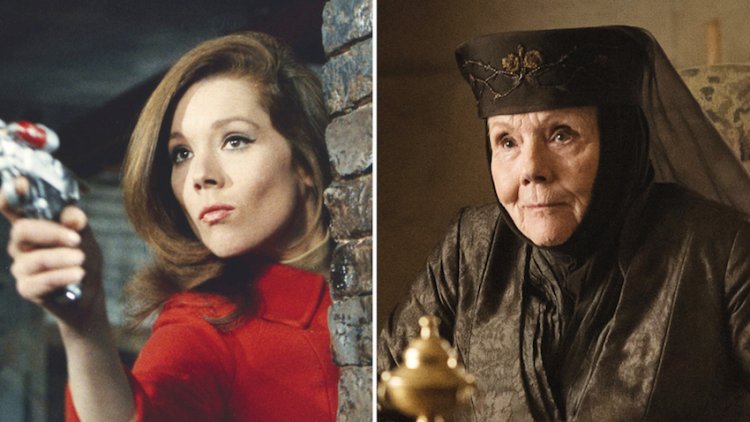Diana Rigg: The Charismatic Force Of Nature

Diana Rigg, a British actress who became a 1960s style icon as secret agent Emma Peel in TV series ‘The Avengers’ has died. She was 82.
Rigg’s agent told BBC, “She died peacefully early this morning. She was at home with her family who have asked for privacy at this difficult time.”
Diana Rigg, known to the young generation for playing the role of Olenna Tyrell in HBO’s Game of Thrones, rose to fame by playing Emma Peel in the 1960s British espionage TV series The Avengers.
Born to Louis Rigg and Beryl Hilda in 1938 Doncaster, England, Rigg spent over seven years of her childhood in Bikaner, Rajasthan, as her father worked for Bikaner State Railway in British India. Rigg learnt Hindi and spoke it as a second language by the time she returned to England after World War II, the BBC reports.
Rigg graduated from school in 1955 and enrolled into the Royal Academy of Dramatic Art, where she trained as an actress for the next two years. She would make her stage debut in The Caucasian Chalk Circle at the 1957 York Festival, and subsequently joined the Royal Shakespeare Company.
Rigg’s fame all but exploded in 1965 when she was cast as Emma Peel on the British spy series The Avengers. The show, which began airing in the United States during Rigg’s debut season, launched her to global recognition thanks to the witty repartee she shared with co-star Patrick Macnee (and her form-fitting attire).
“Becoming a sex symbol overnight shocked me,” Rigg said in a 2019 interview. “I didn’t know how to handle it, and I kept all the unopened fan mail in the boot of my car because I didn’t know how to respond and thought it was rude to throw it away. Then my mother became my secretary and replied to the really inappropriate ones, saying: ‘My daughter’s far too old for you. Go take a cold shower!’”
The play that had brought her to America was Abelard and Heloise, in which she played a young 12th-century Frenchwoman who became a nun in order to be close to her former lover, who had been castrated and forced to live as a monk for his adultery with her. The script was by Ronald Millar, who went on to become Margaret Thatcher’s chief speechwriter, giving her the line “the lady’s not for turning”.
Though it won Rigg the first of her four Tony award nominations, Abelard and Heloise proved in one sense a bad turn for the lady. The critic John Simon, at a time when male reviewers claimed the right to appraise women’s bodies, described her appearance in a nude scene as resembling “a brick mausoleum with insufficient flying buttresses”.
The actor’s response to this misogynistic calumny was characteristically strong-minded and pragmatic. She began to collect brutal reviews other performers had suffered, editing them into a collection, No Turn Unstoned (1989).
Trading fame in TV and film roles to star in a serious new play, though, remained typical of Rigg’s rare ability to move through media and genres. The fact that the first news reports of her death described her as “a star of Game of Thrones” (she was Olenna Tyrell, the matriarch of one of the houses of Westeros, from 2013 to 2017) would have bemused rather than infuriated her, in the way that it might other performers whose long and rich careers are reduced to the most widely recognised element.
She was proud of her populist roles, and untroubled by the part that her striking beauty and physique played in being cast first as Emma Peel in The Avengers (ITV, 1965-68) and then as Tracy opposite George Lazenby’s only outing as 007 in On Her Majesty’s Secret Service (1969).
Although her Avengers character was named by the male writer via a pun on M[an] Appeal, and her Bond character was unusual in marrying the secret agent, both women were tough and independent, qualities that Rigg naturally radiated. Peel ran and fought her way into and out of trouble long before Lara Croft came along. Rigg was also a feminist offscreen: finding out that some male members of the technical crew on The Avengers were earning more than her, she threatened to leave the series unless she received a pay rise, a pioneering example of an equal pay strike in showbiz.
After Abelard and Heloise, she appeared at the National Theatre in London, creating the role of Dorothy Moore, a popular singer married to a much older professor of philosophy, in Tom Stoppard’s Jumpers (1972), bringing her strong singing voice and screen-star glamour to a scene in which she swings onto stage sitting on a vast glittery moon. (In 1978, she created a second Stoppard heroine, Ruth Carson, bored wife of a British mine owner in Africa, in Night and Day. In Hermione Lee’s forthcoming biography of Stoppard, Rigg expresses regret that she only worked with the writer twice; a feeling he shares.)
Jumpers established Rigg as one of the National’s leading stars, which she confirmed with a powerful vocal and physical presence in two modern adaptations of classical French verse plays: The Misanthrope (1973), from Molière, and a Racine adaptation by Tony Harrison, Phaedra Britannica (1975).
But it was emblematic of her professional double-life that, during the same period, Rigg made the cult horror movie Theatre of Blood (1973), which, in another post on her therapeutic journey from that Broadway review to No Turn Unstoned, features a Shakespearean actor taking revenge on drama critics. Her following from Peel and Bond then gave her a shot at American peak-time TV fame. Following the US fashion of actresses (such as Mary Tyler-Moore and Lucille Ball) playing scarcely disguised sitcom versions of themselves, Rigg in Diana (CBS, 1973-74) was “Diana Smythe”, a Brit living in New York. It was moderately successful.
A five-year contract with the Royal Shakespeare Company from 1959 gave her the classical grounding that she would later put to versatile purpose. Prophetically, a Cordelia in King Lear was noted for proto-feminist sassiness and physical strength, which she may have later channelled for Ms. Peel.
Skilled at representing sensuality, Rigg was also effective at suggesting the denial or suppression of sex. Heloise on Broadway was the first of a run of nuns she played across her career. In a TV film, In This House of Brede (1975), from a novel by Rumer Godden, she portrayed a successful businesswoman who enters a convent to renounce monetary success. She was a Mother Superior in the film The Painted Veil (2006) and is another head nun in one of her final roles, due for release next year: another convent-set Godden adaptation, Black Narcissus. This habitual casting reflected her commanding presence but also drew on her interest in spirituality.
Post-Bond, Rigg worked consistently and relentlessly on stage and screen, but it was her turn on Game of Thrones that provided the actress with a huge profile boost toward the end of her life. She was cast as Lady Olenna Tyrell in season three of the hit HBO series, and earned four Emmy nominations for her work—while also providing fodder for countless memes, thanks to her no-nonsense line delivery and matter-of-fact demeanour.
“Obviously, it’s great that has happened, and great it was a young audience- terrific,” Rigg said last year. “That’s the nature of my profession. The young, I don’t expect them to know about my past, but if, through Game of Thrones, they discover me, that’s good.”
“She’s a legend,” Natalie Dormer, her frequent Game of Thrones collaborator, said last year. “Respect is shutting up and listening. Just that dynamic of a younger actress and someone with as much experience as Diana is what I call NAR, which is ‘no acting required.’ She’s one of the earliest feminist figures on our screen. She’s one of the original ’60s feminists.”
Lady Olenna was killed off in season seven, so Rigg wasn’t around for the controversial final season of the show, which even many cast members criticized. But looking back, she was pleased with how her character shuffled off the mortal coil. “I’d love to have stayed on,” she said last year. “Thank God I didn’t die on a toilet like Charles Dance’s character.”
When, by the industry’s harsh judgement of women, the flow of glamour roles slowed from the 1980s, Rigg’s range and training enabled her memorably to explore feminine menace: as Lady Dedlock in an adaptation of Dickens’s Bleak House (BBC, 1985), and a terrifying mother-in-law in Mother Love (BBC, 1989). Both roles, combining classical and horror acting, won her acting awards.
In Ah, But Underneath, a new song Stephen Sondheim wrote for a 1987 London revival of his musical Follies (a back injury prevented her from performing the high-kicking original number), her character laments ‘the curse of versatility’”. But, for Rigg, and her audiences, her ability to do anything was a blessing.
She was the recipient of Bafta, Emmy, Tony, and Evening Standard Awards for her work on stage and screen
Rigg always said she hoped only to be retired from acting by death.
Diana's daughter Rachel Stirling confirmed the news in a statement obtained by Mirror Online.
“My Beloved Ma died peacefully in her sleep early this morning, at home, surrounded by family," Rachael explained.
"She died of cancer diagnosed in March, and spent her last days joyfully reflecting on her extraordinary life, full of love, laughter, and deep pride in her profession. I will miss her beyond words.”
She never retired. One of Rigg’s final television roles was in rural veterinary drama All Creatures Great and Small, which is currently running on British television.
Rigg is survived by her daughter, son-in-law Guy Garvey- lead singer of the band Elbow, and a grandson.
Rest In Peace Diana Rigg!















































